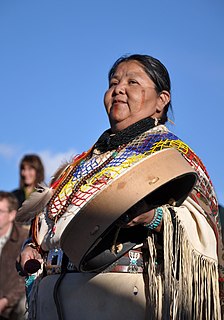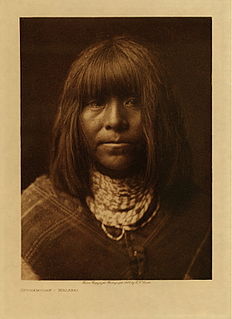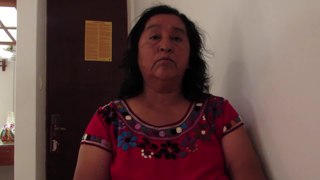Related Research Articles
The Indigenous peoples of Arizona are the Native American people of the state of Arizona. These include people that have lived in the region since time immemorial; tribes who entered the region centuries ago, such as the Southern Athabascan peoples; and the Pascua Yaqui who settled in Arizona in the early 20th century.

The Havasupai people are an American Indian tribe who have lived in the Grand Canyon for at least the past 800 years. Havasu means "blue-green water" and pai "people".
The Achumawi language is the indigenous language spoken by the Pit River people in the northeast corner of present-day California. The term Achumawi is an anglicization of the name of the Fall River band, ajúmmááwí, from ajúmmá "river". nine bands, with dialect differences primarily between upriver and downriver, demarcated by the Big Valley mountains east of the Fall River valley.

The Hualapai is a federally recognized Native American tribe in Arizona with about 2300 enrolled members. Approximately 1353 enrolled members reside on the Hualapai Reservation, which spans over three counties in Northern Arizona.

The Yuman–Cochimí languages are a family of languages spoken in Baja California, northern Sonora, southern California, and western Arizona. Cochimí is no longer spoken as of the late 18th century, and most other Yuman languages are threatened.

Shipibo is a Panoan language spoken in Peru and Brazil by approximately 26,000 speakers. Shipibo is an official language of Peru.

Fox is an Algonquian language, spoken by a thousand Meskwaki, Sauk, and Kickapoo in various locations in the Midwestern United States and in northern Mexico.

The Paipai are an indigenous people of Mexico living in northern Baja California. Their traditional territory lies between the Kiliwa on the south and the Kumeyaay and Cocopa on the north, and extending from San Vicente near the Pacific coast nearly to the Colorado River's delta in the east. Today they are concentrated primarily at the multi-ethnic community of Santa Catarina in Baja California's Sierra de Juárez.

Paipai is the native language of the Paipai, spoken in the Baja California municipality of Ensenada. It is part of the Yuman language family. There are quite a few speakers left, but most are over age 50. Most Paipai now live in Kumeyaay villages.

Havasupai–Hualapai (Havasupai–Walapai) is the Native American language spoken by the Hualapai and Havasupai peoples of northwestern Arizona. Havasupai–Hualapai belongs to the Pai branch of the Yuman–Cochimí language family, together with its close relative Yavapai and with Paipai, a language spoken in northern Baja California. There are two main dialects of this language: the Havasupai dialect is spoken in the bottom of the Grand Canyon, while the Hualapai dialect is spoken along the southern rim. As of 2010, there were approximately 1500 speakers of Havasupai-Hualapai. UNESCO classifies the Havasupai dialect as endangered and the Hualapai dialect as vulnerable. There are efforts at preserving both dialects through bilingual education programs.
Tiipay (Tipay) is a Native American language spoken by a number of Kumeyaay (Kumiay) tribes in northern Baja California and southern San Diego County, California. It is also known as Southern Diegueño. Hinton (1994:28) provided a "conservative estimate" of 200 Tipai speakers in the early 1990s; the number of speakers has declined steadily since that time.
Cocopah is a Delta language of the Yuman language family spoken by the Cocopah. Cocopah is believed to have derived from the Hokan language, and it is related to the other Native American languages of Mojave and Kumeyaay. Cocopah is considered an endangered language, with fewer than 400 speakers at the turn of the 21st century. However, in an effort to keep the language alive, Yuma County's Cocopah Museum began offering classes teaching Cocopah to children in 1998.

Colorado River Numic, of the Numic branch of the Uto-Aztecan language family, is a dialect chain that stretches from southeastern California to Colorado. Individual dialects are Chemehuevi, which is in danger of extinction, Southern Paiute, and Ute. According to the Ethnologue, there were a little less than two thousand speakers of Colorado River Numic Language in 1990, or around 40% out of an ethnic population of 5,000.

The Yavapai are a Native American tribe in Arizona. Historically, the Yavapai – literally “people of the sun” – were divided into four geographical bands who identified as separate, independent peoples: the Ɖulv G’paaya, or Western Yavapai; the Yaavpe', or Northwestern Yavapai; the Gwev G’paaya, or Southeastern Yavapai; and the Wiipukpaa, or Northeastern Yavapai – Verde Valley Yavapai.
Picuris is a language of the Northern Tiwa branch of Tanoan spoken in Picuris Pueblo, New Mexico.
The phonology of the Zuni language as spoken in the southwestern United States is described here. Phonology is a branch of linguistics that studies how languages or dialects systematically organize their sounds.

Southern Athabaskan is a subfamily of Athabaskan languages spoken primarily in the Southwestern United States with two outliers in Oklahoma and Texas. The language is spoken to a much lesser degree in the northern Mexican states of Sonora, Chihuahua, Durango, Coahuila, and Nuevo León. Those languages are spoken by various groups of Apache and Navajo peoples. Elsewhere, Athabaskan is spoken by many indigenous groups of peoples in Alaska, Canada, Oregon and northern California.
Tampuan is the language of Tampuan people indigenous to the mountainous regions of Ratanakiri Province in Cambodia. As of the 2008 census there were 31,000 speakers, which amounts to 21% of the province's population. It is closely related to Bahnar and Alak, the three of which form the Central Bahnaric language grouping within the Mon-Khmer language family according to traditional classification. Sidwell's more recent classification groups Tampuan on an equal level with Bahnar and the South Bahnaric languages in a larger Central Bahnar group. The Tampuan language has no native writing. EMU International began linguistic research in 1995 and produced an alphabet using Khmer letters. The alphabet was further refined by linguists from International Cooperation for Cambodia (ICC) and the Ministry of Education, Youth, and Sport (MOEYS). The modified Khmer script was approved by MOEYS in 2003 for use in bilingual education programs for Tampuan implemented by ICC, UNESCO, and CARE.
Tarangan is one of the Aru languages, spoken by inhabitants of the Aru Islands in eastern Indonesia. There are two "Tarangan" varieties: East and West Tarangan. These varieties are divergent, perhaps no closer than they are to Manombai, also spoken in the Arus. West Tarangan is a trade language of the southern islands.
The Takelma–Kalapuyan languages are a proposed small language family that comprises the Kalapuyan languages and Takelma, which were formerly spoken in the Willamette Valley and the Rogue Valley in Oregon.
References
- Biggs, Bruce. 1957. Testing Intelligibility among Yuman Languages. In International Journal of American Linguistics. Vol. 23, No. 2. (April 1957), pp. 57–62. University of Chicago Press.
- Mithun, Marianne. 1999. The Languages of Native North America. Cambridge University Press.
- Shaterian, Alan William. 1983. Phonology and Dictionary of Yavapai. University of California, Berkeley.